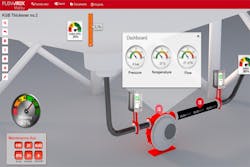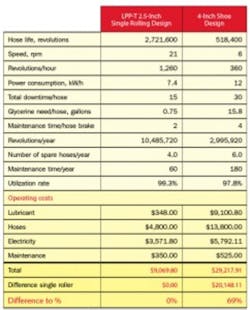The mining industry uses peristaltic pumps for many duties. In fact, industrial peristaltic pumps have been in existence since the 1930s. Many applications for metering chemicals can be served by different positive displacement pumps, including electric or air-operated diaphragm pumps (AODD), progressive cavity pumps and peristaltic pumps. Each type has its own benefits and shortcomings.
Each of the various styles of pumps has been in existence for half a century or more and has proven to be suitable for mining service. Peristaltic pumps have been the fastest growing category of positive displacement pumps since 2005. Advances in rubber technology are one reason that these type pumps have gained in popularity. Rubber is the heart of a peristaltic pump, and if it does not work or survive for reasonable periods of time, then the pump is frequently out of service for repair.
Peristaltic pumps are successfully used for clean chemicals and reagents. Their low shear capabilities deliver benefits when delivering polymers or flocculants in mining. The pumps also do not damage the long polymer chains and, therefore, allow the chemicals to reach their maximum effectiveness. An improperly chosen pump for delivering flocculants will damage the polymer chains and prompt the user to have to use more flocculants to perform the intended function.
Common mining applications
One of the most common applications in the mining industry for peristaltic pumps is pumping highly concentrated solids. Peristaltic pumps typically prove their greatest effectiveness in this area. A common application is thickener underflow. The percent solids of mineral slurries may be 35 percent or up to 80 percent in a thickener underflow application. At 35 percent solids, a rubber-lined centrifugal pump may be used. At 80 percent solids a centrifugal pump typically cannot be used. At 55 percent solids either a peristaltic pump or a centrifugal pump may be used. However, a peristaltic pump may be a better solution because the wear parts of a centrifugal pump typically wear at a much greater rate with higher solids content.
Peristaltic pumps have become more popular in thickener underflow for numerous reasons when compared to centrifugal pumps. The peristaltic pump user can accurately control thickener underflow at a wide range of flow rates. A peristaltic pump does not have a flow curve but rather produces an exact flow per revolution. For this reason, the flow rate produced by the pump is controlled by increasing or decreasing the speed. The advantage is that the pump can be controlled at the very low flow rates as well as at near top revolutions per minute, unlike a centrifugal pump curve that may become difficult or impossible to control at low flow rates.
In a thickener, time and money are spent to thicken a slurry. Centrifugal pumps include mechanical seals that dilute the thickened sludge, and the need for gland seal water has a continuous cost to the operation. A peristaltic pump has no mechanical seals and requires no seal water. Those costs are eliminated with peristaltic pump use. Other advantages come with having the capability to pump thickened slurries up to 80 percent solids. For instance, pumping 80 percent solids means pumping a significantly less total volume. Energy consumption, piping sizes, valves, instrumentation, number of filtration chambers, retention time in filtration, size of other process equipment and make-up water costs are all reduced. When you calculate the savings, the amount can be large, assuming that the mining operation is in an area where water is abundant. This is the case with some operations, but many mines are located in areas where water is a scarce resource. If this is the situation, then peristaltic pumps become much more attractive.
Shoe style design
Table 1. User feedback on operating costs for 2.5-inch single roller design pump compared to 4-inch shoe design pump
Peristaltic pumps can be quite different in the way they close or occlude the hose to create the flow through the pump. One of the designs includes two metal bumps or metal shoes attached to arms 180 degrees opposite each other, which rub against the rubber hose to push the material forward and out of the pump. A significant limiting factor of this "shoe" style is how fast, or number of revolutions per minute, the pump can run. The reason is because this type of design is friction-based. The shoes generate heat as they rub against the rubber hose. If this heat is controlled, the pump will continue to heat up, destroy the rubber hose and lead to shorter bearing life. This style of peristaltic pump utilizes large amounts of glycerin to help transfer the heat from the hose and internal components to the casing of the pump. This glycerin becomes a significant cost to the end user. A 3-inch (80-millimeter) pump may require 8 to 10 gallons of glycerin at about $100 per gallon. When the hose fails, this glycerin is waste and needs to be replaced. One thousand dollars of waste glycerin is discarded with every hose failure.
Even with a large amount of glycerine use, this pump type has rpm limitations. These designs have flow curves that have two areas of operation. In the lower portion of the flow and pressure curve, it is called "continuous duty." However, when the pressure and flow rates increase, the pump may be pushed into the intermittent duty area of the flow and pressure curve. This will mean that the pump cannot be run continuously and will need to be shut down every two hours for cooling. The only way to move back into a continuous portion of the curve is to either slow the rotation speed down or use a larger diameter pump that rotates at a slower speed. A larger diameter pump will have a higher price tag and greater maintenance costs.
Shoe-designed peristaltic pumps also compress the rubber hose twice per revolution. This is important because the No. 1 determining factor in how long a rubber hose will last is how many times it is compressed, not the material or slurry going through the hose. Heat also has a negative impact on hose life if it goes above the temperature rating of the rubber material.
Finally, shoe design peristaltic pumps require more energy than designs that are based on a rolling principle.
Rolling designs
Figure 2. A two-shoe, double compression design peristaltic pump generates enormous heat, utilizes large amounts of glycerin to cool the pump and has shorter hose life because of the required two compressions per revolution.
Two techniques are employed in rolling designs. One is two rollers at the end of two arms 180 degrees opposite each other, and the other incorporates an eccentric cam shaft, which only compresses the hose once every 360-degrees revolution. Both designs completely eliminate the heat issue generated by shoe design peristaltic pumps. However, the single-roller design also eliminates 50 percent of the compressions. For this reason, a single-roller design will increase hose life by two to five times and in almost all cases a smaller pump diameter can be used to create the same flow rate. Roller designs have much lower operating torques, so less energy is consumed by rolling peristaltic pumps. Finally, rolling designs require a fraction of the glycerin required by shoe pumps. A 3-inch roller pump will require 2 gallons of glycerin compared to the shoe design that requires 10 gallons. This will result in $800 of savings per hose change. In most cases, a 3-inch shoe design pump may be replaced by a 2.5-inch or 2-inch rolling design because of the advanced technology of the single roller design.
All the features of a single-roller peristaltic pump design can have significant operational cost savings compared to shoe design peristaltic pumps and centrifugal pumps.
Todd Loudin is president and CEO of Flowrox Inc., located in Linthicum, Maryland, since 2002. Loudin has a Bachelor of Science in marketing and executive MBA from Loyola College, Baltimore. For more information on peristaltic pump technology, visit flowrox.com. Loudin may be reached at [email protected].




